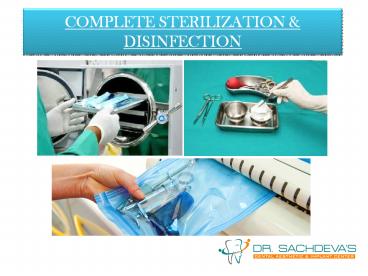Complete Sterilization & Disinfection - PowerPoint PPT Presentation
Title:
Complete Sterilization & Disinfection
Description:
Our work is carried out to the highest of standards by professionals with extensive expertise and knowledge of dentistry, led by Dr. Rajat Sachdeva. – PowerPoint PPT presentation
Number of Views:483
Title: Complete Sterilization & Disinfection
1
COMPLETE STERILIZATION DISINFECTION
2
- Patients health safety is our prime
concern while managing a patient in the dental
office. Preventing transmission of contagious
viruses is of the utmost concern for us. Hence we
follow all the sterilization disinfection
procedures needed for infection control.
3
- Sterilization
- Sterilization is the destruction of all forms
of microbial life by heat, chemical sterilant, or
gas.
- Disinfection
- Disinfection is the process that eliminates
many disease producing micro-organisms on
inanimate objects, with the exception of
bacterial spores.
4
Why Sterilization is needed?
- Whenever any equipment is taken into use
left unchecked or not disinfected properly, it is
highly likely that bacteria will grow, thus in
order to prevent spread of debilitating diseases
sterilization is mandatory .
5
- Uses of Sterilization
- Sterilization for surgical procedures Gloves,
aprons, Surgical instruments, Syringes etc. - Sterilization of culture media, reagents
equipments to maintain a sterile condition.
6
Sterilization Disinfection
High Temperature Moist or heat/steam or dry heat Low Level Kills most vegetative bacteria, some viruses some fungi
Low Temperature ozone Chemical Liquid sterilants, hydrogen peroxide Intermediate Level kills vegetative bacteria, viruses, fungi mycobacterium
Gas Ethylene oxide High Level kills all microbial organisms- potential to render device sterile
Radiation Gamma, e-beam Thermal Disinfection via thermal applications under 100 degrees Celsius
7
- Factors affecting efficacy of disinfection
sterilization - Number location of microorganisms
- Bio films
- Duration of exposure
- Organic inorganic matter
- Physical chemical factors
- Concentration potency of disinfectants
- Innate resistance of microorganisms
8
- Sterilization Methods
- Disinfection Methods
- Physical Methods
- Moist heat in Autoclave
- Dry heat in ovens
- Gamma irradiation
- Filtration
- Plasma sterilization
- Chemical Methods
- Ethylene oxide
- Glutaraldehyde (high concentration)
- Physical Methods
- Boiling Pasteurisation
- UV radiation
- Chemical Agents
- Alcohols
- Aldehydes
- Halogens
- Phenols
- Surfactants
- Heavy metals
- Dyes
- Oxidants
9
- Hot air oven
- is an apparatus with double metallic walls
and a door. There is an air space between these
walls. - The apparatus is heated by electricity or
gas at the bottom. On heating, the air at the
bottom becomes hot and passes between the two
walls from below upwards, and then passes in the
inner chamber through the holes on Me top of the
apparatus. A thermostat is fitted to maintain a
constant temperature of 160C.
10
- It Is one of the most common method used for
sterilization. Glass wares, swab sticks,
all-glass syringes, powder and oily substances
are sterilized in hot air oven. For
sterilization, a temperature of 160C is
maintained (holding) for one hour. Spores are
killed at this temperature. It leads to
sterilization.
11
- Autoclave
- Moist heat destroys microorganisms by the
irreversible denaturation of enzymes structural
proteins. The temperature at which denaturation
occurs varies inversely with the amount of water
present. - Recommendations for sterilization in an
autoclave are 15 minutes at 121C.
12
- Working of Autoclave
- On the lid, there are (1) A gauge for
indicating the pressure, - (2) A safety valve, which can be set to blow
off at any desired pressure, and - (3) A stopcock to release the pressure. It
is provided with a perforated diaphragm. Water
is placed below the diaphragm and heated from
below by electricity, gas or stove. - (a) Place materials inside,
- (b) Close the lid. Leave stopcock open,
- (c) Set the safety valve at the desired
pressure,
13
- (d) Heat the autoclave. Air is forced out and
eventually steam ensures out through the tap, - (e) close the tap. The inside pressure now rises
until it reaches the set level (i.e. 15 min),
when the safety valve opens and the excess steam
escapes, - (f) Keep it for 15 minutes (holding time),
- (g) Stop heating,
- (h) Cool the autoclave below 100C,
- (i) Open the stopcock slowly to allow air to
enter the autoclave.
14
- For more information, you can book an appointment
at - Dr Sachdeva Dental Aesthetic And Implant ,
- I 101, Ashok Vihar Phase 1, Delhi- 110052
- Contact us at
- Phone 919818894041,01142464041
- Our Websites
- http//goo.gl/yI8lGv
- http//goo.gl/DquAGr
- http//goo.gl/GsCcoS
- Google link https//goo.gl/vqAmvr
- Facebook link https//goo.gl/tui98A
- Youtube link https//goo.gl/mk7jfm
- Linkedin link https//goo.gl/PrPgpB
15
(No Transcript)

